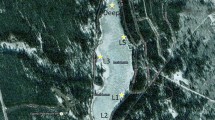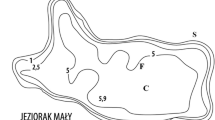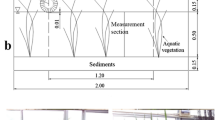Abstract
Experiments with replanting macrophytes in Lake Chao showed that the water quality inside an Alternathera philoxeroides Griseb.and a Phragmites australis community were better than outside. Transparency was significantly higher and the content of N and P decreased inside the communities, as did the rate of sedimentation of organic suspended matter in the Phragmites australis community. Modeling revealed that macrophyte restoration could decrease phytoplaniton biomass, increase fish biomass, exergy, structural exergy, zooplankton/phytoplankton ratio and transparency (Xu et al., 1999b). It is concluded that macrophyte restoration can purify lake water, regulate lake biological structure and control eutrophication.
Similar content being viewed by others
References
Baker, L. A., 1992. Introduction to nonpoint source pollution in the United States and prospects for wetland use. Ecol. Eng. 1: 1–26.
Brix, H. & H.-H. Schierup. 1989. The use of aquatic macrophytes in water-pollution control. Ambio 18: 100–107.
Carpenter, S. R., 1981. Submersed vegetation: an internal factor in lake ecosystem succession. Am. Nat. 118: 372–383.
Clasen, J., W. Rast & S. O. Ryding, 1989. Available techniques for treating eutrophication. In: Ruding S. O. & W. Rast (eds), The Control of Eutrophication of Lakes and Reservoirs. Man and the Biosphere Series vol. 1. UNESCO. Paris: 264 pp.
Conley, L. M., R. I. Dick & L. M. Lion, 1991. An assessment of the root zone method of wastewater treatment. Res. J. Water Pollut. 63: 239–247.
Cooke, G. D., E. B. Welch, S. A. Peterson & P. R. Newroth, 1993. Restoration and Management of Lakes and Reservoirs (2nd Edn). Lewis Publ: 548 pp.
Cooper, P. F. & B. C. Findlater (eds), 1990. Constructed Wetlands inWater Pollution Control. Proceedings of the International Conference on the Use of Constructed Wetlands in Water Pollution Control. Pergamon. Oxford: 77–84.
Grimm, M. P., 1994. The influence of aquatic vegetation and population biomass on recruitmant of 0+ and 1+ northern pike (Esox Lucius L.). In Cowx, I. G. (ed.), Rehabilitation of Freshwater Fisheries. Fisheries News Books, Blackwell, Oxford: 280 pp.
Gumbricht, T., 1992. Tertiary wastewater treatment using root-zone method in temperature climate. Hydrobiologia 170: 245–266.
Gumbricht, T., 1993. Nutrient removal capacity in submersed macrophyte pond systems in a temperate climate. Ecol. Eng. 1: 49–61.
Hammer, D. A. (ed.), 1989. Constructed Wetlands for Wastewater Treatment: Municipal. Industrial and Agricultural. Lewis, Chelsea, MI: 831 pp.
Hammer, D. A. (ed.), 1992. Designing Constructed Wetlands to Treat Agricultural Nonpoint Source Pollution. Ecol. Eng. 1: 49–82.
Horne A. J. & C. R. Goldman, 1994. Limnology (2nd edn). McGraw-Hill, Inc: 576 pp.
Jørgensen, S. E., 1995. Exergy ald Ecological Buffer Capacities as Measures of Ecosystem Health. Ecosystem Health 1: 150–160.
Li, W. & Q. Yan, 1995. Wetland utilization in Lake Taihu for fish farming and improvement of lake water quality. Ecol. Eng. 5: 107–121.
Ma, S., 1985. Ecological engineering: application of ecosystem principles. Envir. Conserv. 12: 331–335.
Mitsch, W. J. & J. G. Gosselink, 1986. WETLANDS. Van Nostrand Reinhold Company, New York: 539 pp.
Mitsch, W. J., 1992. Landscape design and the role of created, restored and natural riparian wetlands in controlling nonpoint source pollution. Ecol. Eng. 1: 27–47.
Mitsch, W. J. & S. E. Jørgensen (eds), 1989. Ecological Engineering: An Introduction Ecotechnology. Wiley, New York: 185–217.
Moss, B., J. H. Stansfield, K. Irvine, M. R. Perrow & G. L. Phillips, 1996. Progreesive restoration of a shallow lake – a 12-year experiment in isolation, sediment removal and biomanipulation. J. appl. Ecol. 33: 71–86.
Nichols, D. S., 1983. Capacity of natural wetlands to remove nutrients from wastewater. J. Wat. Pollut. Cont. Fed. 55: 495–505.
Patten, B. C., 1990. Waterlines and shallow continental water bodies. Volume 1. Natural and human relationships. SPB Academic Publishing: 759 pp.
Rast, W. & M. Holland, 1988. Eutrophication of lakes and reservoirs: a framework for making management decisions. Ambio. 17: 2–12.
Reed, S. C., E. J. Middlebrooks & R. W. Crites, 1988. Natural Systems for West Management & Treatment. McGran Hill. New York: 588 pp.
Reed, S. C. (ed.), 1990. Natural Systems for Wastewater Treatment. Manual of Practice FD-16. Wat. Pollut. Cont. Fed., Alexandria, U.S.A: 260 pp.
Rich, P. H., & R. G. Wetzel, 1978. Detritus in the lake ecosystem. Am. Nat. 112: 57–71.
Ryding, S. O. & W. Rast, 1989. The control of eutrophication of lakes and reservoirs. Man and the biosphere series vol. 1. UNESCO. Paris: 265 pp.
Scheffer M., M. Van der Berg, A. Breukelar, C. Breukers, H. Coops, R. Doef & M.-L. Meijer, 1994. Vegetated areas with clear water in turbid shallow lakes. Aquat. Bot. 49: 193–196.
Tilton, D. L. & R. H. Kadlec, 1979. The utilization of a freshwater wetland for nutrient removal from secondary treated waste water effluents. J. envir. Qual. 8: 328–334.
Tu, Q. Y., D. X. Gu, C. Q. Yi, Z. R. Xu & G. Z. Han, 1990. The Researches on the Lake Chao Eutrophication. The publisher of University of Science and Technology of China. Hefei: 225 pp. (in Chinese).
Van Donk, E., R. D. Gulati & M. P. Grimm, 1989. Food web manipulation in lake Zwemlust: positive and negative effects during the first two years. Hydrobiol. Bull. 23: 19–34.
Wang, S. Y., C. S. Jin, R. X. Meng & F. L. Xu, 1995. Environmental Research for the Lake Chao in Anhui Province. In Jin, X. C. (ed.), Lakes in China (Volume one). China Ocean Press: 580 pp.
Wolverton, B. C., 1987. Aquatic plalts for wastewater treatment: An overview. In Reddy, K. R. & W. H. Smith (eds), Aquatic Plants for Water Treatment and Resources Recovery. Magnolia Pub. Inc., Orlando, FL: 3–16.
Xu, F. L., 1994. Scientific Decision-making System for Environmental Management of the Lake Chao Watershed. Environ. Protection. 21(5): 36–39.
Xu, F. L., 1996. Ecosystem health assessment of Lake Chao, a shallow eutrophic Chinese lake. Lakes & Reservoirs: Research and Management, 2: 101–109.
Xu, F. L., 1997. Exergy and structural exergy as ecological indicators for the development state of the Lake Chao ecosystem. Ecol. Model. 99: 41–49.
Xu, F. L., S. E. Jøgensen & S. Tao, 1999a. Ecological indicators for assessing freshwater ecosystem health. Ecol. Model. 116: 77–106.
Xu, F. L., S. E. Jøgensen, S. Tao & B. G. Li, 1999b. Modeling the effects of ecological engineering on ecosystem health of a shallow eutrophic Chinese lake. Ecol. Model. 117: 239–260.
Author information
Authors and Affiliations
Corresponding author
Rights and permissions
About this article
Cite this article
Xu, FL., Tao, S. & Xu, ZR. The restoration of riparian wetlands and macrophytes in Lake Chao, an eutrophic Chinese lake: possibilities and effects. Hydrobiologia 405, 169–178 (1999). https://doi.org/10.1023/A:1003867309767
Issue Date:
DOI: https://doi.org/10.1023/A:1003867309767




